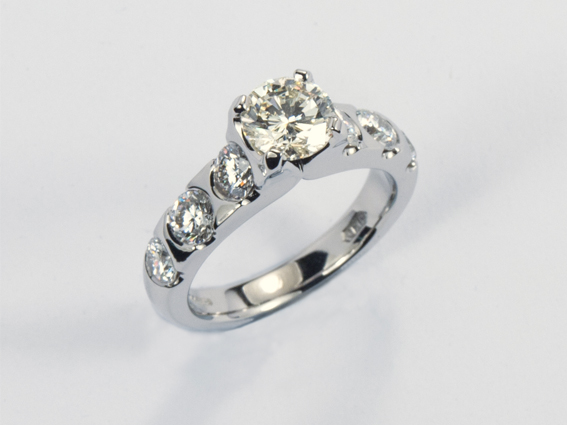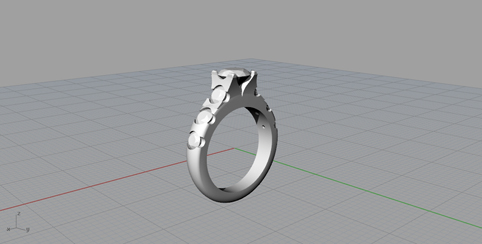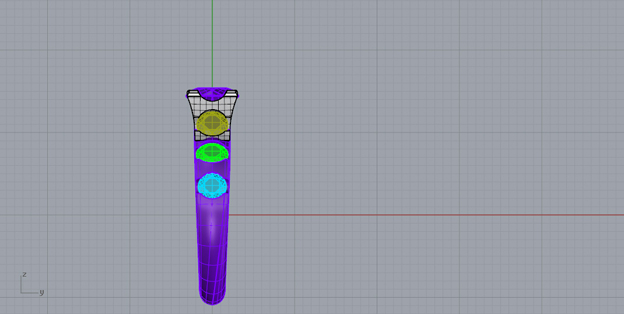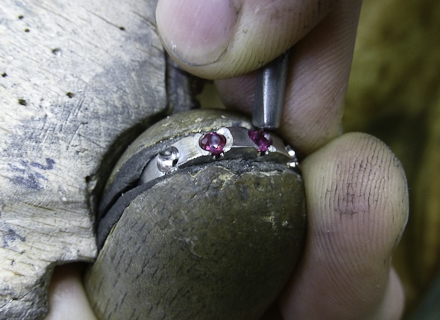Jane's ring - Part 2 - the designer, the CAD star and the craftsman
01 July 2016
OK, so I talked in the first post about how the initial process of Jane's ring went, the intial meeting and the design process. If you missed that first blog, you can find it here!
The bit I missed in the first blog, was that Jane's initial decison, was whether to set her diamond from her engagement ring, in to one of our single stone four claw rings, and use the diamonds from her eternity ring, to make a Jon Dibben endset ring, or amalgamate everything in to one new ring.
We talked about the decision, and Jane opted for the latter, a decision that I am pleased to say that she is still really happy with. Further discussion took us down the route of amalgamating 3 elements of 3 of our designs in to a new design. We developed this design on CAD (Computer Aided Design) which we have been using in the workshop for many years now.

Now we still handmake, in a very traditional way, everything that we can. All or wedding rings, and eternity rings are made in a way that the majority of the commercial jewelllery world would just laugh at. Too much time, too much effort, too much human! But CAD is a reality, and it has real benefits!
Even people very close to us surprise me by their impression of the CAD process. They imagine that you press a few buttons and then sit back and relax, while the computer designs the ring, working out tolerances, structural strength and all the tricky bits for you. The truth is very far from this. For a start, building anything on CAD, takes a real discipline and knowledge, and also can take a lot of time. It only produces what you tell it to build, nothing more, nothing less. All the thinking about everything above is done by us, ane we have to control all of this and make the jewellery look beautiful. We are really lucky to have Hannah, whose ability in CAD is incredibly impressive, tied in with her impecable eye for line and proportion.

So where is the advantage, why do we do it, if it's so hard? Well, as a designer that's an easy one. Because I'm interested in the design, along with the craftmanship. I'm doing this to see my designs, my ideas, become reality. Now in the past, I would have sketched the ring, as well as I could manage, and then start to make it. Now if I got some of the way through making the ring, and realised that I wasn't so keen on elemements, that possibly didn't show up in the drawing, because err, it's just a drawing, then it was really hard to justify starting again, because of the time invested or materials used or the deadline approaching. So you might end up with a design that was maybe 80 to 90% as good a you hoped. With CAD, we regularly hit 95%+, because we can revisit the design till we get it right, and I can tell you, that's a great thing!
I'm handing over to Chris now, to talk about the ring from his place, sitting at the workbench. He is intrinsically involved in the design process, both aesthetically and technically, but on this ring, he was also the one who turned all the design time in to a beautiful piece of jewellery!

I remember when I was a jewellery design student thinking that one of the differences between 'design' and 'art' is that design has to pay more attention to a broader range of criteria beyond primarily the meaningful, beautiful and/or provocative representation of an idea. A design often has to also give equal consideration to aspects of, for example; commercial viability, functionality, longevity and efficiency. I suppose the success of a good design is also more tangible because several of the criteria, such as profitability and reliability are quantifiable and measureable, rather than more subjective.
While 'art' is exciting because the possibilities are so wide, in some ways, the stricter discipline of making something beautful which will also appeal in a competitive retail market, which can be made or manufactured economically, and which 'functions' in the broadest sense, is also exciting in a different way. Stephen Bayley wrote in The Guardian about the architecture of The Lightbox in Woking regarding the awkward shape of the site; "Constraints are an inspiration to genius, not an impediment to it".

Chris pushing the metal down on one of our Ruby end set rings
While I'm not sure that genius was required, we did have to have a bit of a think about a new issue with setting Jane's ring. The setting for the diamonds down the shoulders of the ring are an 'end-set' style where the sides of the setting are open, with the stones held by two opposing 'C' shapes of metal around the girdle of the stone. Normally, each setting is on a convex curve made by the circular ring shape, but Jane's ring had concave curves forming the sweep up to central stone.
As for many types of setting, once a hole is made for the stone, it is secured in place by pushing very hard on the top edge of the hole, moving a rim of metal down and over the edge of the stone. If your imagination needs a hand, think of the platinum as plasticine and it might help! The issue with Jane's concave shoulders, was that what was normally a nice acute angled edge which you can push down easily, was now a much less pleasing obtuse angled edge, which to make matters worse, because of the all-important spacing of the stones from the 'top-view', was positioned very close to the void which formed the claws of the central stone.
At the design stage, much guesstimating and modellling was done to get the best balance, and in the process of setting the stones at the bench, I used a combination of pushing almost backwards on the setting edge to raise a rim of metal below the edge, then finishing moving the rim and burnishing it to a polished finish with a shiny burnisher made by grinding down the shaft of an old ball burr.
.jpg)
The end result is that we're really happy that the spacing of the stones looks balanced, the facets and angles of the metal which forms the setting surfaces and claws are balanced and don't crash into each other, and from a completely functional point of view, the diamonds will stay secure and solid in their holes for decades to come!
Thanks for reading!
Chris and Jon
teapsup
25 March 2022 at 3:20 p.m.
Generic Bentyl Website Pills Store https://oscialipop.com - cialis online ordering Zzlnfc <a href=https://oscialipop.com>cialis order online</a> cialis precio andorra Yzflxv Rwdetn Viagra Sales Outlets https://oscialipop.com - Cialis Olgfck Amoxicillin No Prescription
Leave a comment
Your email address will not be published. Required fields are marked *